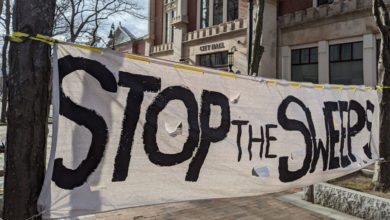California’s environmental regulatory system and its systemic failures has been increasingly questioned by residents of the East San Gabriel Valley community in Los Angeles. The struggle for a safe environment is exacerbated by Quemetco’s chronic toxic contamination from the byproducts of lead-smelting and the failure of state agencies like the Department of Toxic Substance Control to protect communities from toxic exposure. This is further evidenced in the fractured renewal process enabled by DTSC allowing Quemetco to continue its ongoing pollution.
DTSC’s settlement agreement with Quemetco
In a meeting in early February, 200 community members attended a Settlement Agreement Workshop hosted by DTSC. The community demanded answers to DTSC’s failure to regulate Quemetco’s egregious violations, such as the containment leak in the building used to store hazardous waste and the failed implementation of a proper groundwater monitoring network for nearly two decades. The San Gabriel aquifer, a source of drinking water for 1.2 million SGV residents, faces a risk of further contamination due to DTSC failing to fulfill its job.
Various community organizations like the Clean Air Coalition of North Whittier and Avocado Heights, composed of residents who live in the surrounding neighborhoods of Avocado Heights, Hacienda Heights and North Whittier, have led the struggle to demand changes from Quemetco for over a decade. These residents overwhelmingly agree that Quemetco has not been adequately penalized in the latest settlement.
Rebecca Overmyer-Velázquez, an environmental justice professor and the founder of the Clean Air Coalition, shared her thoughts. “The Settlement Agreement Workshop was an attempt to make it look like the DTSC is on the side of the community. It was really just a smokescreen for what really happened. They let Quemetco get away with breaking California law.”
The agency is in the hotspot for what the community sees as a slap on the wrist. While DTSC is legally allowed to fine facilities as much as $25,000 per day for unauthorized, intentional, or negligent hazardous waste disposal, it only fined Quemetco $2.3 million. Quemetco could have been fined anywhere from $150 million to $2 billion for the 29 violations they have committed. A fine within this margin would have been proper, considering that the facility brings in an annual revenue of $34 million.
Overmyer-Velázquez added, “If they really used the fining mechanism to deter a facility like Quemetco from committing violations on a regular basis, then that fine would be at least in the hundreds of millions of dollars, because of how long it’s been going on and how serious these high level violations are. The DTSC had a chance finally to really put a [dent] on the company, and they didn’t.”
Due to the settlements, Quemetco’s violations will no longer impede the facility’s permit renewal. It also places Quemetco closer to realizing a long-contested expansion that will surely further contaminate the SGV — a clear failure of DTSC’s fundamental responsibilities.
Fractured permitting division and weak enforcement
The broken permit renewal process and DTSC’s inability to enforce regulations shows the agency’s blatant disregard for the public. Residents around Quemetco have waited for the permit renewal decision since the facility’s permit expired in 2015. Despite well-documented pollution, DTSC delayed this process since 2015, placing residents’ lives at risk. California also has a track record of allowing waste facilities to operate for an extended period with expired permits. For example, another serial violator, Phibro-Tech, has been operating in Santa Fe Springs with an expired permit since 1996.
For nearly a decade, the Clean Air Coalition has worked on preventing postponements and to pressure DTSC to deny Quemetco’s permit renewal. However, the grassroots efforts are highly outmatched by Quemetco’s ability to hire expensive lawyers to draw out the process near indefinitely. Overmyer-Velázquez commented: “We don’t get much, but at least every 10 years we’re supposed to get a say in how these facilities operate, and we haven’t had that chance since 2004. That’s almost 20 years where DTSC has let Quemetco do whatever it wants without public oversight. You can’t help but think that there’s intent here to just keep us waiting and finally have us give up.” In the City of Industry, environmental laws are just a formality.
The class character of DTSC
The DTSC’s mission claims to protect California’s people, communities and environment from toxic substances, however, the agency has failed to carry out its most basic function. An investigation conducted by Consumer Watchdog found that the agency serves as a revolving door for corporate lawyers, lobbyists, and regulators, along with other patterns that reveal the extent of the influence that industry holds over the agency. These groups manipulate the system of regulation to empower their associates — polluters, clean-up contractors, developers, and other private entities — to make a profit, not regulate or protect communities.
The DTSC has the power to revoke, or deny permits, and to prosecute executives. When asked why DTSC fails to regulate Quemetco, one Avocado Heights resident shared, “A lot of the people that are lobbying for Quemetco are former employees of the agency. Quemetco’s consultants are good at bobbing, and weaving, going around in circles, and appealing. They’ve managed to influence the agency and [let] … Quemetco slide.”
The controversy surrounding the DTSC’s new Board of Environmental Safety also reveals the ongoing influence that industry poses over the agency. In 2021, a statewide effort led by environmental justice organizations succeeded in pressuring the state of California to institute a new set of reforms, including this new board.
The campaign for reform was born out of years of distrust of the DTSC by impacted communities. The BES’s intended purpose is to promote transparency, accountability, more public engagement, and thus better oversight of the DTSC’s staff. But the Board has already fallen short of grassroots and community expectations. It is understaffed and structured to prevent the public from actively playing a decisive role.
The BES enacted new set policies that defers decision-making to the DTSC staff regarding appeals. This defeats the purpose of the Board at its core and allows DTSC to have the final word on appeals to its earlier decisions, essentially keeping DTSC corruption intact.
Quemetco is among a number of facilities that pollute the environment, protected from accountability through its extensive wealth. While DTSC appears to be failing, in reality it is successfully upholding its real interests of serving the polluters, either through feigning attempts at regulation or through undermining its democratic processes, and refusing to enforce industry compliance.
The people will bring Quemetco to justice
DTSC and Quemetco have worked closely to maximize profits as they pollute the community for generations. Holding both institutions accountable and reclaiming the right to a healthier environment from industry benefactors will take a grassroots-led movement. Rather than a list of attorneys, lobbyists, and consultants, regulatory agencies like the DTSC must be composed of community members — those who live adjacent to hazardous waste facilities who best understand the consequences of improper regulation and weak enforcement.
The Clean Air Coalition, composed of residents in surrounding neighborhoods, have been leading this fight, not because they have a private stake in the matter, but because they care about people, the environment and future generations. Similar community-led struggles offer hope to the CAC. For example, another polluting lead smelter, Exide, was shut down permanently in 2015 through a long people’s struggle.
CAC is building a campaign to stop the DTSC from renewing the facility’s permit. The public comment period will begin on June 21, and a decision is expected by the end of the year. Over the next couple of months the coalition will continue to draw more neighbors into the struggle, pressure local representatives to take a stand, conduct demonstrations to make their voices heard and pressure the DTSC to side with the people once and for all.






